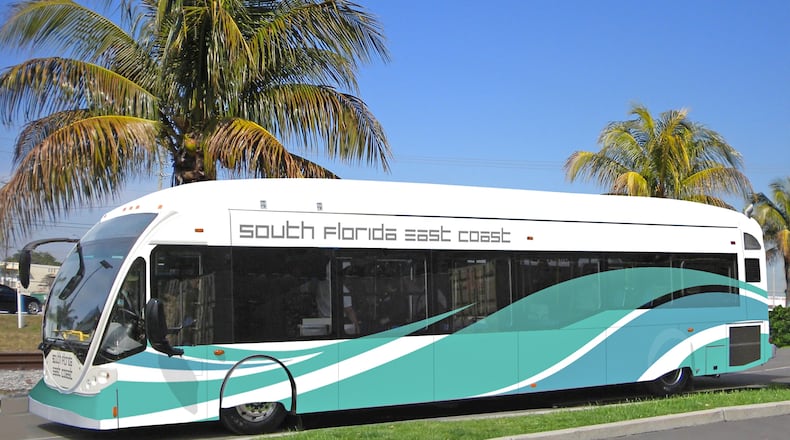The federal government plans to award MARTA $12.6 million for a new bus rapid transit line from Georgia State Stadium to Midtown Atlanta, a project that could boost mobility and redevelopment of neighborhoods south of I-20.
The 9.4-mile Summerhill Bus Rapid Transit project would connect the Summerhill neighborhood south of I-20 — anchored by Georgia State University — to MARTA’s Arts Center Station. The route will include stations and vehicles linking Midtown, Piedmont Park, downtown, existing MARTA rail stations and the new Summerhill mixed-use development.
The $48.6 million transit line is tentatively set for construction in 2021 and would open by 2024. The project includes the purchase of about five new bus rapid transit vehicles and the installation of about 30 transit stations. Supporters say the vehicles and stations will be sleeker and more sophisticated than a typical city bus.
The U.S. Department of Transportation awarded the grant through its Transportation Investment Generating Economic Recovery (TIGER) program.
Georgia’s two senators, Johnny Isakson and David Perdue, announced the grant Wednesday, and U.S. Rep Drew Ferguson, R-West Point, played a role in obtaining it as a member of the House Transportation and Infrastructure Committee.
The neighborhoods south of I-20 are cut off from the rest of downtown and other jobs centers by the interstates.
Mayor Keisha Lance Bottoms called the project “a long overdue investment in an often-overlooked area of our city.”
“The dividends paid by investing in south Atlanta will boost our economy and lift up communities long waiting for opportunity,” Bottoms said. “This news is further evidence of what can be accomplished when we reach across partisan and governmental lines to work together for a common good.”
BRT lines run with limited stops and operate in exclusive lanes and sometimes shared roadways.
“We are incredibly excited to see BRT in Atlanta,” said MARTA Chairman Robbie Ashe. “BRT has been widely successful in the United States and abroad, and I’m excited to see it come to Atlanta. We look forward to working with U.S. DOT and the city on this transformative project.”
The BRT line likely will give a substantial boost to the redevelopment of Summerhill and the neighborhoods south of I-20 and around Georgia State Stadium, making the area much more attractive to corporations and retail tenants.
How Summerhill and the future development will connect to downtown and the airport are the first questions corporate tenants and their brokers ask about the project, said Carter President and CEO Scott Taylor.
With the BRT line, the neighborhoods will have a quicker transit connection to downtown, the main MARTA rail network and to Hartsfield-Jackson International Airport.
A number of recent high-profile corporate expansions, such as NCR and PulteGroup, have located near MARTA lines as more employers insist on transit to provide their workers with alternatives to driving.
The BRT systems will also provide mobility options for seniors, students, workers and guests.
“For the community, this provides that critical link to major jobs centers they’ve never had,” he said. “We really believe this transit connectivity will helps reshape the southside of Atlanta for decades to come.”
The Atlanta Braves wanted a direct connection to MARTA when they were in talks with the city to remain at the former Turner Field, before the ballclub left for the new SunTrust Park in Cobb County. Residents also listed mass transit as a priority in planning sessions designed to map out the future stadium redevelopment.
Georgia State University acquired Turner Field in January 2017, and the university and a development team also acquired surrounding parking lots. The developers, led by Atlanta-based real estate firm Carter, plan a mixed-use community on the former stadium property and in the old brick storefronts along Georgia Avenue. The total investment could one day top $1 billion.
Carter and its partners have restaurants and retail slated for the first phase, along with office space and apartments. A student housing development is also planned near Georgia State Stadium in the first phase.
“The TIGER grant is a massive game changer for Summerhill and the stadium neighborhoods,” Taylor said.
MARTA’s application for the grant calls for 10-minute “headways” between buses on the loop, and service would run 16 hours per day. The project would include lane enhancements, traffic signal priority systems for the buses and “queue jump lanes” for buses to move more easily through traffic.
Isakson and Perdue hailed the announcement.
“The rapid bus project, once completed, will offer much better links between neighborhoods, office buildings, higher education institutions and medical facilities that area residents rely on daily,” Isakson said.
“When the I-85 bridge collapsed, MARTA proved to be critical to moving Georgians around Atlanta,” Perdue said. “It’s great to see the federal government not only recognizes the value of MARTA, but also is willing to invest further in this infrastructure asset.”
The Latest
Featured





